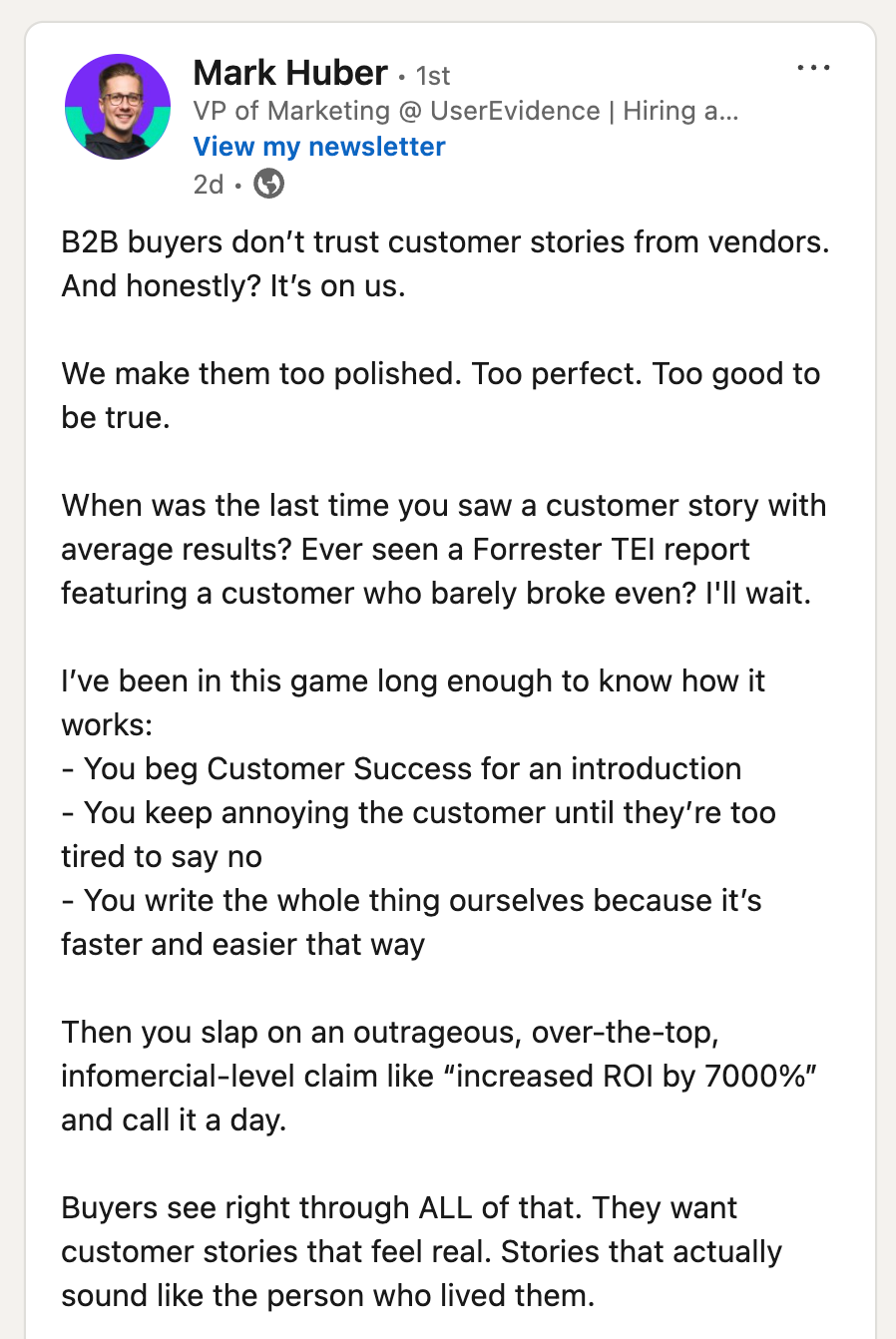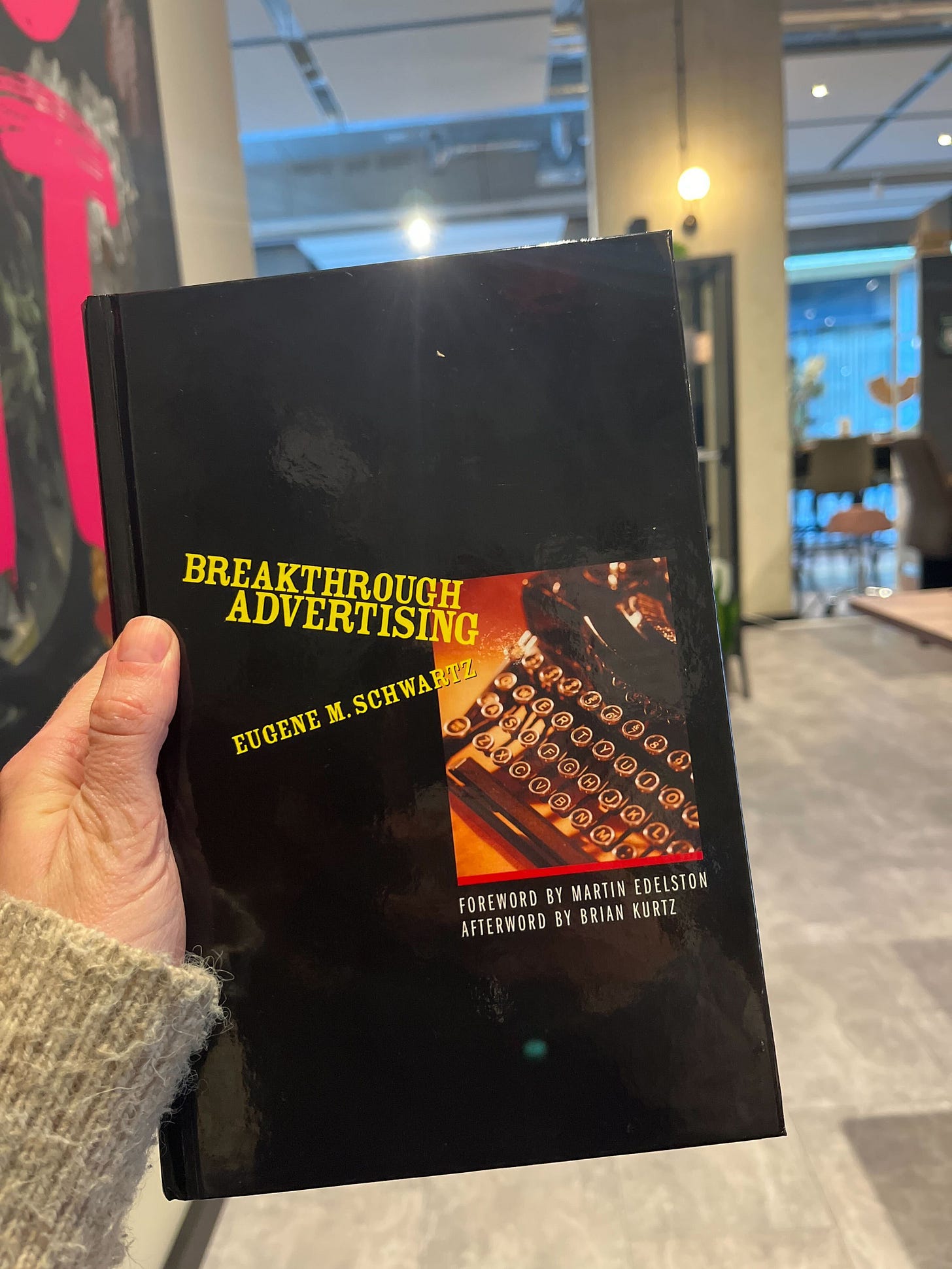Hey, team.
Happy 2025. 🎉
I love this time of year. I love getting a chance to start fresh on something. I love the energy. I’m feeling excited to get back to work after 3 weeks of bopping around 9 different time zones.
And one of the things I’m most excited about right now is this right here. This little corner of the Internet that I’m fortunate enough to share with you.
This month marks the start of my third year in business. After two years of focusing 100% on bringing in revenue, it’s time to step back and think about the bigger picture.
The biggest change that’s coming your way? A totally revamped content strategy that’s based around the first principles of copywriting.
This year my goal is to work through the stack of marketing/copywriting books I’ve collected and analyze the shit out of them. Each week, this newsletter will give you hands-on, practical advice from the greats with examples and insights from my own career.
So if you (or someone you know) is looking for a newsletter that:
Teaches the foundational elements of copywriting and marketing
Wants super-practical advice on how to think about your messaging
Is comprehensive, but still fun to read.
You’ve found the right place. 🪄
How to pick a message.
Every product gives you dozens of messaging keys. But only one will unlock the door to sales.
^That’s according to advertising great Eugene Schwartz, whose book Breakthrough Advertising is considered the marketing and sales Bible (and has been since its publication in 1966).
I finally got a copy of this book after pining over it for several years, and I can easily say that it’s worth all the hype (and worth its weight in gold). Every sentence is a highlightable nugget of insight.
Today, I want to cover the first big lesson from it: how to find what your market wants.
How to pick a messaging frame.
The first few chapters of Schwartz’ book make it crystal clear the copywriters should not try to create demand for a product. Instead, our role is simply to find a desire in the market, and channel it towards our product.
The reason is pretty simple: trying to create desire is kind of an expensive waste of time.
The truth is that market desire is a lot like a force of nature. It’s dictated by things like politics, religions, folklore, physical location, climate, beliefs, random events, scientific discoveries... all of which are like gale-force winds that you can’t control, no matter how big your budget is.
Plus, even if you did engineer a sense of desire in the market, it’s really easy to lose control. Take a look at what’s happening with Justin Baldoni and Blake Lively right now. Baldoni’s PR propaganda machine did a fantastic job of convincing most people that Lively was a nightmare to work with… until Lively showed up with a lawsuit that threatens his carefully-crafted public image as a feminist.
All it takes is ONE video, ONE Reddit post, or ONE comment to change public opinion. You think anyone predicted the obsession with Moo Deng or capybaras? TikTok is like a tornado — a trend forms without warning, generates panic, then disappears without a trace. People are fickle, and the Internet even more so.
So, instead of trying to CREATE desire, advertisers — especially if you’re in the small business world like I am — need to ride on the coattails of whatever desire is present at a given moment. To quote Schwartz, your message needs to, “take the hopes, dreams, fears and desires that already exist in the hearts of millions of people, and focus those already-existing desires onto a particular product.” Otherwise, you spend millions educating the market on something, just so other companies can come in and help the public form their opinion about it.
Schwartz calls these forces “nationwide mass desires.” As a marketer, you need to be attuned to them.
How to pick a mass desire for your product.
Mass desire is “the public spread of a private want.” It’s the collective hopes, dreams, frustrations, fears, and opinions of a group that’s large enough to justify a market.
This desire ^ is the context in which you frame your product. It’s a huge part of your positioning. It’s the most important decision you’ll make, because it’ll become the foundation for everything else that you do.
The trick to getting it right is to pick ONE desire, and building a message around it that positions your product as an obvious way of satiating it.
There’s a lot to say on this (Schwartz wrote a whole book on it, after all), and I don’t want to make this newsletter 8000 words long. I’ll be writing a lot more about this in the coming weeks, so make sure you’re subscribed if you want to get all the details.
HOWEVER, a way to get started is to just start reading the room in your market.
While it’s true that mass desires are shaped by lots of different forces that are beyond your control, Schwartz breaks them down into two general categories that you can explore:
Permanent Forces are desires that never change. Look at the rise of the skincare industry for the last few years. It’s a new solution to the age old problem of wanting to stay young and beautiful. There are underlying desires of the human condition that never change — the desires for shelter, security, love, acceptance, power, status.
Forces of Change are desires that shift with the seasons. These are things like trends, global events, seasonal offers, et cetera. I’d put Moo Deng into this category, or any messaging changes that we saw in the early days of the pandemic when companies started offering their streaming services for free.
As a marketer, you need to do your research to try and understand what’s happening in your industry, where people are unhappy, and where they want to be. Then you have to figure out what about your product fits into that larger cultural narrative.
The key to it all though? The desire has to be big enough that people will spend money to fix it. Otherwise your messaging might resonate… but be targeting the wrong problem.
B2B Example: UserEvidence.
One company I think is doing a great job of tapping into a growing Force of Change is UserEvidence. I worked with them on retainer for 7 months last year so I’m obviously biased, but the team there really knows what they’re doing.
Their whole business is built around the insight that nobody in B2B really believes your customer case studies, and that buyers don’t trust vendor-created content anymore.
Instead, buyers are going to closed communities to get software recommendations — then using things like G2 or Capterra to explore further.
That’s it. That’s the thing that’s occupying the market’s mindshare. They didn’t create this idea or have to educate the market about it. They just said the truth out loud, which is how they grab your attention. 👇

You can only choose ONE desire.
There are a lot of great takeaways here, but the big one is to be ruthless in your messaging prioritization.
This is something I see go wrong a LOT in messaging strategies. When you build them internally and end up with a 30-page manifesto, it’s just a corral for a lot of different messaging ideas.
^THIS makes it really hard to write copy. When it comes time to actually write a headline, we’re forced to cram a million ideas into 30ish characters. You end up with stuff like “Save time with flexible automation,” which is far from distinct.
Overall, this is why I think most massive messaging strategies are pointless, why a 3-5 page doc is better than a deck, and why messaging pillars are a waste of time…
… but it all comes down to the fact that your campaigns, website, and company need to have ONE clear idea, not seven. When you figure out the main desire, everything else kind of falls into place.
Get laser-focused. Think like a writer. Ask yourself what you’d put on a four-word billboard.
^That’s how you narrow down to the most salient desire.
Up next: How to link your product to the market needs.
This week’s newsletter touched on how to find out what your audience wants… but we’ve barely scratched the surface of Schwartz’ introductory sections. Next week I’m going to talk about how to map your product to the market desire (and how this process helps you figure out what features to focus on).
Stuff I’m digging from other people this week.
Jess Wheeler wrote a fucking fantastic post about AI-generated influencers, why it’s a strategy that’s destined to fail, and how so many marketing teams lose the plot when it comes to AI.
One of my partner design agencies, Kohde, is hiring a Senior Brand and Digital Designer. I love the Kohde team and they work on some pretty interesting products. This is a seriously awesome opportunity for anyone who is obsessed with design.
If you’re looking for an Account Executive to join your team in Germany, Lisa Ziegler is your gal.
Heike Young had a great post about why we need to stop saying we “churn out” content.
Stuff I’ve been writing this week.
If you like any of these, I’d massively appreciate a thumb’s up and/or a comment. It’s the easiest way to help more people see what I’m doing. 🙏
I hope you like this new format. ✨
I know your inbox is crowded, and I take your subscription seriously. It’s truly an honor to be part of your world.
I hope this new content format — analyzing the shit out of the greats, and talking about marketing first principles — resonates. As a subscriber you’ll get deeper dives than I can put on LinkedIn, plus you’ll get the insights first (all of the lessons from today’s letter are going out on LinkedIn in a few weeks!).
If you have any feedback, ideas, questions, or suggestions, hit reply and let me know. I want this to be the best damn marketing newsletter you read every week — and 2025 is the year of leveling it up.
Appreciate you. Have a great weekend.


